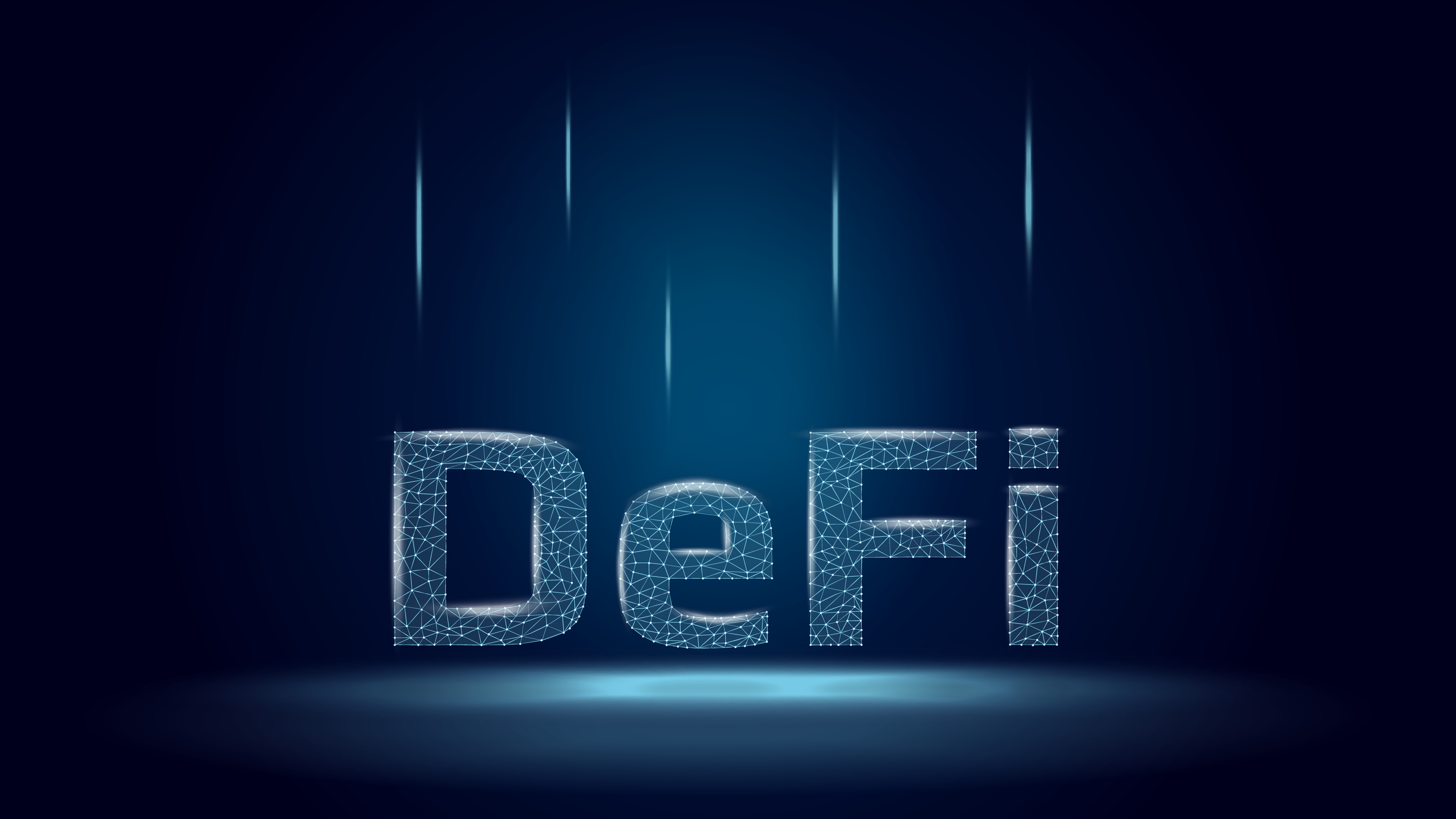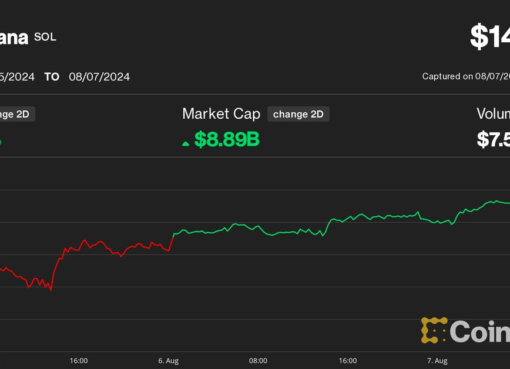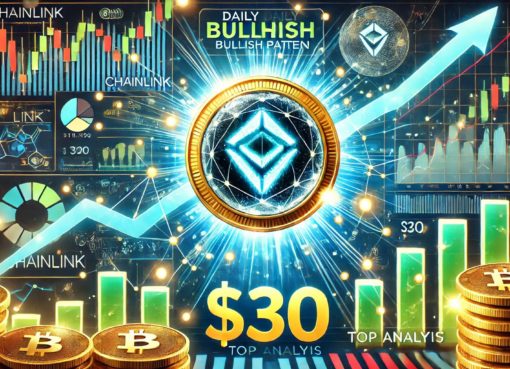Decentralized Finance, commonly known as DeFi, is rapidly reshaping the landscape of financial transactions and systems in our increasingly digital world. This innovative approach to finance merges traditional monetary processes with the cutting-edge technology of blockchain, offering a more accessible, transparent, and efficient financial system.
In this guide, we delve into the question “What Is DeFi”, we aim to demystify decentralized finance, illustrating its importance and impact in today’s financial and cryptocurrency landscapes.
What Is DeFi?
DeFi, short for Decentralized Finance, represents a paradigm shift in the way we think about financial services. At its core, DeFi is an umbrella term for a variety of financial applications in cryptocurrency or blockchain geared toward disrupting financial intermediaries.
Unlike traditional banking systems that rely on institutions like banks and governments, DeFi operates on a decentralized network, typically using blockchain technology. This means that DeFi platforms are not controlled by any single entity and are instead maintained by a distributed network of computers.
DeFi encompasses a broad spectrum of financial services, including lending, borrowing, trading, investment, and insurance, all without the need for a central authority. This approach aims to democratize finance by making these services accessible to anyone with an internet connection, reducing costs, and increasing transaction speed and transparency.
DeFi Explained: How It Challenges Traditional Finance
DeFi stands in stark contrast to traditional finance in several key ways. The most notable difference is the elimination of intermediaries. In traditional finance, banks, brokers, and other financial institutions act as gatekeepers, controlling access to financial services and often creating bottlenecks. DeFi, however, uses blockchain technology and smart contracts to facilitate direct peer-to-peer transactions, effectively removing these intermediaries.
This decentralization offers numerous advantages:
- Lower Fees: Without intermediaries charging for their services, DeFi platforms can significantly reduce transaction costs. This cost efficiency is particularly beneficial in cross-border transactions, where traditional banking fees can be substantial.
- No Central Point Of Control: In traditional finance, centralized systems create points of vulnerability, where failure or attack can have widespread repercussions. DeFi’s decentralized nature mitigates this risk, distributing operations across a blockchain network, enhancing security and resilience.
- Accessibility And Inclusivity: DeFi democratizes finance by providing access to financial services to anyone with an internet connection, regardless of location or status. This is particularly crucial for unbanked or underbanked populations who have limited access to traditional banking services.
- Transparency And Auditability: Blockchain’s transparent ledger allows for greater visibility into transactions and smart contract operations, fostering trust among users.
The Role Of Blockchain
Blockchain is the backbone of DeFi. It’s a distributed ledger technology that records transactions across multiple computers in a way that ensures the data cannot be altered retroactively. This technology enables the creation of smart contracts – self-executing contracts with the terms of the agreement directly written into lines of code. Smart contracts automate and enforce the terms of an agreement, eliminating the need for intermediaries and reducing the chances of fraud.
In DeFi, blockchain not only ensures the security and transparency of transactions but also allows for the creation of decentralized applications (dApps) that operate on this technology. These dApps provide various financial services directly to users, bypassing traditional financial institutions and reducing costs. The innovation of blockchain in DeFi represents a significant step towards a more open, inclusive, and efficient financial system, promising to revolutionize the way we interact with money.
DeFi In The World Of Cryptocurrency
DeFi within the cryptocurrency realm is a transformative force, redefining the very essence of financial transactions. This space, termed ‘DeFi crypto,’ is characterized by the utilization of cryptographic assets to power a myriad of financial services traditionally monopolized by banks and centralized institutions.
Understanding DeFi Crypto
The intersection of DeFi with cryptocurrencies, commonly referred to as “DeFi crypto,” marks a significant milestone in the evolution of digital finance. This synergy allows for the creation and management of financial products and services in a decentralized environment, free from traditional banking constraints and centralized control.
DeFi crypto platforms enable users to lend, borrow, trade, and earn interest on their cryptocurrency holdings in a trustless manner. These activities are conducted via smart contracts, which autonomously execute the terms of a contract when certain conditions are met, thereby eliminating the need for intermediaries.
The term “DeFi crypto” encompasses a wide range of applications and protocols that operate on blockchain technology, allowing for innovative financial solutions such as yield farming, liquidity mining, and decentralized exchanges (DEXs). These DeFi protocols offer users complete control over their financial assets, with enhanced privacy and security, which is a significant shift from the traditional finance model.
DEXs are at the heart of DeFi crypto activity. Uniswap, for example, stands out as a leading DEX, providing liquidity through an automated market maker (AMM) protocol rather than a traditional order book. It allows users to swap ERC-20 tokens directly from their wallets, contributing to the pool and earning fees proportionate to their share. Other DEXes like SushiSwap have followed suit, iterating on Uniswap’s original protocol with additional features and incentives.
What Are The Most Popular DeFi Blockchains?
Ethereum, widely known as the leading blockchain for DeFi applications due to its early adoption of smart contract functionality, is not alone in the space. Several other blockchains have become significant DeFi players, with their popularity often measured by Total Value Locked (TVL).
TVL in DeFi refers to the aggregate value of assets locked within a decentralized finance (DeFi) protocol. It signifies the amount of crypto assets, such as tokens, staked or deposited by liquidity providers in various DeFi platforms. TVL is a crucial metric for assessing the overall health and popularity of a DeFi protocol. It helps determine user demand and the protocol’s attractiveness to investors.
Top-10 Blockchains
As of November 11, below is the list of the most popular DeFi blockchains based on data from DefiLlama:
- Ethereum: Despite high gas fees, Ethereum’s TVL of $25.559 billion and daily active users amounting to 355.267 speak to its dominance and pioneering role in DeFi. It remains the largest and most widely used blockchain for DeFi, hosting numerous protocols like MakerDAO, Aave, and Compound.
- Tron: Tron’s significant TVL of $8.331 billion, coupled with its massive 1.59 million daily active users, underscores its popularity, especially in Asian markets. Its DeFi ecosystem is fueled by high throughput and effective community engagement strategies.
- Binance Smart Chain (BSC): BSC has attracted a considerable number of users, with 957.028 daily active users and a TVL of $3.004 billion, due to its compatibility with Ethereum’s assets and lower transaction costs.
- Solana: Known for its speed and low fees, Solana has a TVL of $561.84 million and 179.363 daily active users. It hosts Serum, a high-speed, non-custodial DEX, and other innovative DeFi projects that exploit its fast block times.
- Polygon: As a scaling solution for Ethereum, Polygon enhances transaction speed and reduces costs, with a TVL of $832.66 million and 346.808 daily active users. It serves as a sidechain that runs alongside the main Ethereum chain, hosting popular DApps like QuickSwap and Aavegotchi.
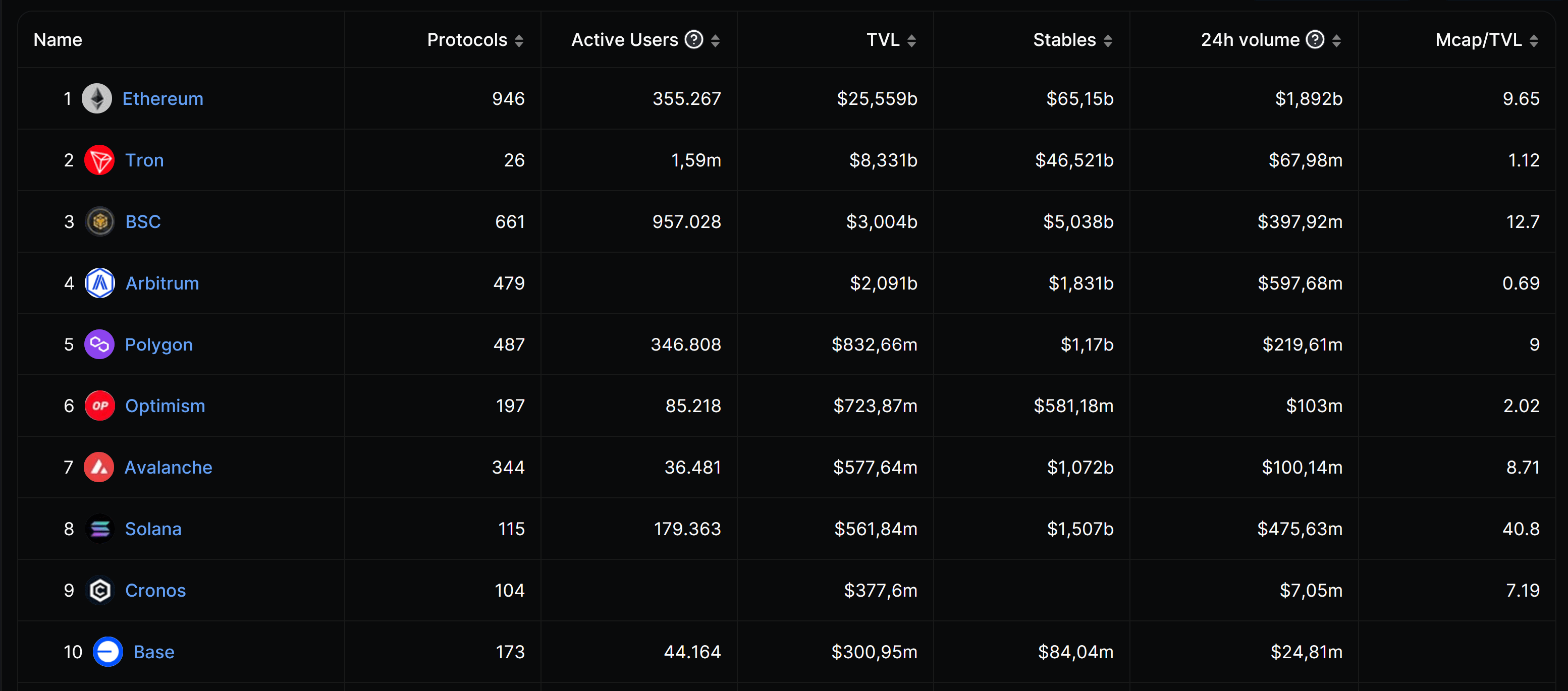
Best Decentralized Finance Applications
DeFi is home to a multitude of applications, each striving to offer unique and compelling financial services. Based on the latest data from DappRadar, here’s an overview of the top DeFi applications, distinguished by their Total Value Locked (TVL), which signifies the amount of capital they have secured within their respective protocols:
- Lido: At the zenith of the list with a TVL of $18.27 billion, Lido stands out as the most prominent liquid staking solution. It allows Ethereum holders to stake their ETH while retaining liquidity, facilitating participation in the network’s security without sacrificing asset accessibility.
- MakerDAO: With a TVL of $5.31 billion, MakerDAO is a trailblazer in the DeFi space. It’s a decentralized credit platform on Ethereum that manages the DAI stablecoin, pegged to the US dollar, and allows users to open collateralized debt positions (CDPs) to generate DAI.
- Uniswap V3: Commanding a TVL of $3.57 billion, Uniswap V3 is the latest iteration of the popular DEX, offering improved capital efficiency for liquidity providers through concentrated liquidity positions.
- Aave V3: Aave V3 has garnered a TVL of $3.27 billion and is known for its innovative approach in decentralized lending. It allows users to lend and borrow a diverse range of cryptocurrencies with varying interest rate options.
- Aave V2: Preceding its successor, Aave V2 holds a TVL of $2.96 billion. It introduced features such as collateral swapping and stable borrowing rates, which have been instrumental in advancing the DeFi lending landscape.
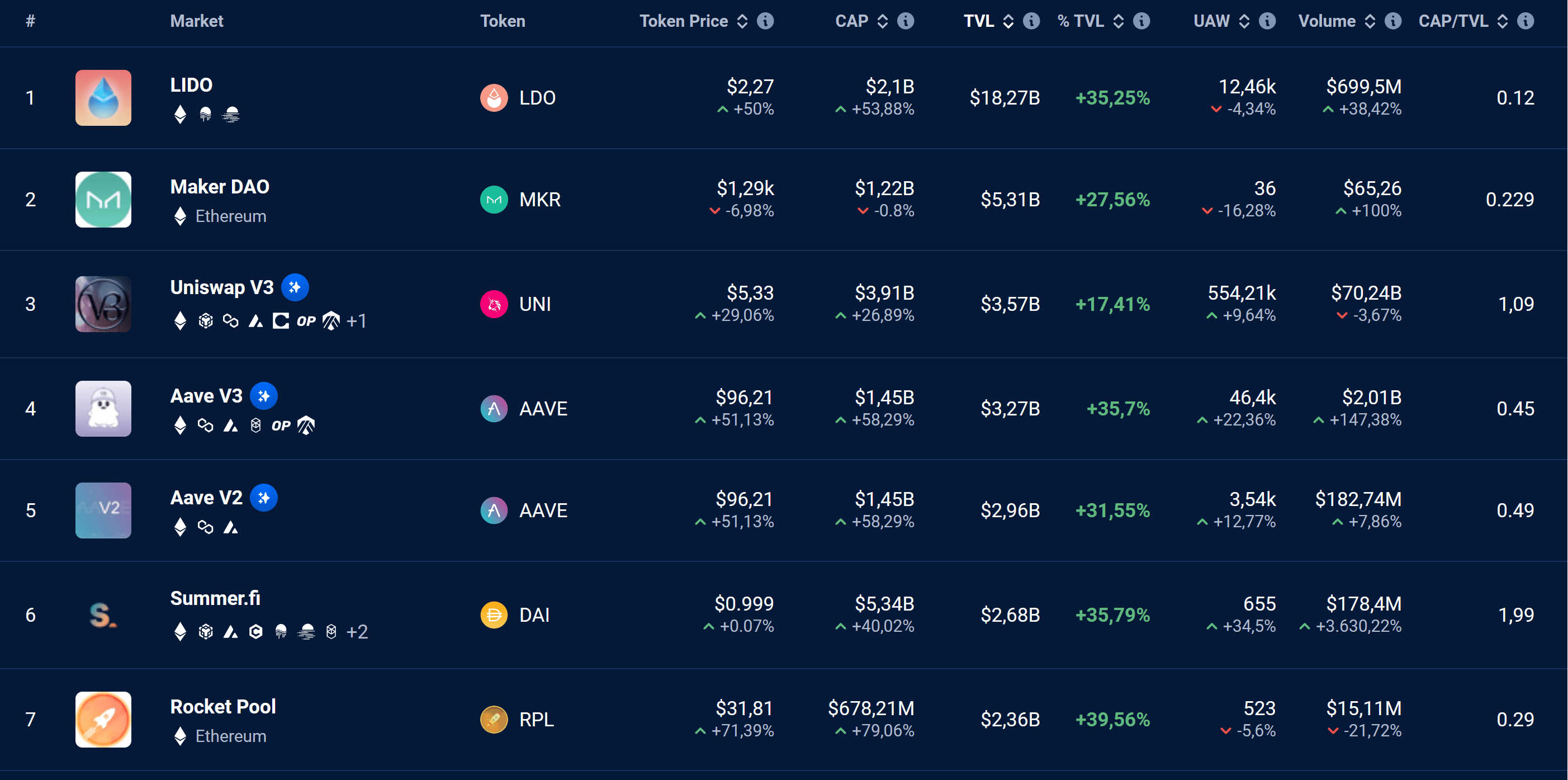
DeFi Staking Explained
DeFi staking is a process that involves locking up one’s cryptocurrency holdings to support the operations of a blockchain network and, in return, earning rewards. In DeFi, staking is not merely a support mechanism for the network, but also a way for users to earn passive income on their crypto holdings. This is achieved through various DeFi protocols that offer staking services.
When users stake their cryptocurrencies within a DeFi protocol, they typically transfer their assets into a smart contract, which then uses those assets in various network functions such as validating transactions if it’s a Proof of Stake (PoS) blockchain, or providing liquidity. The users’ staked assets help maintain the security and efficacy of the platform or network.
In return for staking their assets, users receive rewards, usually in the form of additional tokens. The rate of return can vary widely, depending on the platform and the demand for the asset being staked. Some DeFi protocols also offer additional incentives such as governance rights, where users can participate in decision-making processes regarding the future development of the protocol.
Platforms like Synthetix and Curve Finance exemplify DeFi staking. On Synthetix, users stake SNX tokens to mint synthetic assets, while on Curve Finance, users stake stablecoins to earn trading fees and CRV tokens. The complexity of staking varies across platforms, with some offering simple ‘deposit and earn’ mechanisms, while others may require active participation in governance or other network activities.
What Is Liquidity Mining?
Liquidity mining is a key concept in DeFi that incentivizes users to supply liquidity to decentralized exchanges and other financial applications by rewarding them with governance tokens. This process is fundamental to Automated Market Makers (AMMs), which are at the core of many DeFi trading platforms.
In liquidity mining, users deposit two assets that form a trading pair into a liquidity pool. For example, a user might supply both Ethereum and USDC to the ETH/USDC pool. By providing liquidity, they enable other users to trade between these two assets more efficiently. The liquidity provider (LP) gets a share of the transaction fees generated from trades that happen in that pool, proportional to their share of the pool’s total liquidity.
Beyond transaction fees, liquidity miners also earn additional rewards, typically in the form of the platform’s native tokens. These tokens can carry significant value and often grant holders governance rights, allowing them to vote on proposals that can affect the platform’s direction and tokenomics. The phenomenon of liquidity mining really took off with the emergence of Compound’s COMP token, which was distributed to users who borrowed or supplied assets to the protocol, kicking off the “yield farming” craze in the summer of 2020.
While liquidity mining can offer substantial returns, it’s not without risks. Users can experience an impermanent loss when the price of your deposited assets changes. Additionally, smart contract vulnerabilities pose a risk, as exploitation of these vulnerabilities can lead to a loss of funds.
What Is Yield Farming?
Yield farming, a cornerstone activity within DeFi, is an investment strategy that involves staking or lending crypto assets to generate high returns or rewards in the form of additional cryptocurrency. This process, akin to earning interest in a traditional bank, takes advantage of the intricate incentive structures built into many DeFi protocols.
Investors engage in yield farming by adding their assets to a liquidity pool, which is essentially a smart contract that contains funds. In exchange for their contribution, participants obtain liquidity tokens, which they can subsequently utilize to garner additional rewards. The DeFi platform typically generates these rewards from transaction fees, or sometimes they come from new tokens released during a promotion.
For instance, protocols like Compound distribute their native COMP tokens to users who lend or borrow on their platform. Similarly, users who provide liquidity to Uniswap’s pools earn a portion of the trading fees in addition to potential UNI token rewards. These incentives can be quite lucrative, leading to the rapid growth and popularity of yield farming within the DeFi ecosystem.
Notably, yield farming involves high complexity and significant risks, such as smart contract vulnerabilities, impermanent loss (a change in the value of deposited assets compared to their value at the time of deposit), and the volatility of reward tokens. Yet, it remains a popular method for crypto-savvy users to potentially grow their holdings by leveraging the DeFi sector’s innovative protocols.
DeFi Explained: Risks And Rewards
DeFi’s allure is largely due to its high-yield opportunities and the democratization of financial services. Users can engage directly with markets, offering liquidity, borrowing, lending, and earning potential returns that far surpass traditional banking products. For example, protocols like Yearn.finance have popularized yield farming, where investors can earn rewards by staking or lending cryptocurrency assets.
Yet, DeFi is not without substantial risks. One of the most significant risks comes from smart contract vulnerabilities. High-profile incidents like the hack of The DAO, where attackers drained $50 million worth of Ether due to a smart contract exploit, and the recent Poly Network attack, leading to the siphoning off of over $600 million (though largely returned later), highlight the potential for catastrophic losses.
Market volatility can lead to the rapid devaluation of assets, as seen in the May 2021 market crash, where DeFi markets experienced significant stress. Furthermore, the absence of a regulatory safety net means there’s no FDIC insurance equivalent, leaving users fully exposed if their funds are lost or stolen.
What Is The Future Of DeFi Crypto
The trajectory of DeFi crypto is anticipated to be revolutionary, with potential integration into mainstream finance and the creation of more complex financial instruments. This integration could see the likes of Aave or Compound potentially working alongside or within traditional financial institutions, bringing liquidity and new lending mechanisms to the market.
However, the road ahead is fraught with challenges that need addressing. Expected changes in regulatory frameworks could legitimize DeFi platforms by ensuring their compliance with global financial regulations. This could mitigate one of the most pressing risks: the uncertainty and the “Wild West” nature of the current DeFi landscape.
The future also likely holds more advanced security protocols to prevent exploits and hacks, which have historically plagued platforms like dForce and Harvest Finance, resulting in losses worth millions. Improved security, alongside enhanced user experience, could help in reducing the entry barrier for less tech-savvy users, broadening DeFi’s appeal.
Another anticipated development is the rise of “DeFi 2.0”, with protocols that address the issues of its predecessor, such as impermanent loss in liquidity pools or the sustainability of yield farming rewards. With these advancements, coupled with a possible increase in institutional involvement, DeFi crypto stands to redefine not only how we understand finance but how we interact with money in a digital age.
FAQ: What Is Decentralized Finance (DeFi)?
What Is DeFi?
DeFi, or Decentralized Finance, refers to a movement that aims to create an open-source, permissionless, and transparent financial service ecosystem that operates without central authorities. Blockchain networks host DeFi systems, which use smart contracts to offer services that include banking, loans, asset trading, and complex financial instruments.
What Is Decentralized Finance?
Decentralized Finance is a term synonymous with DeFi. It represents the shift from traditional, centralized financial systems to peer-to-peer finance enabled by decentralized technologies built on the blockchain.
What Is DeFi Crypto?
DeFi crypto refers to the use of cryptocurrency within DeFi systems. It involves the application of crypto assets to engage in financial activities such as earning interest, borrowing, lending, and trading through decentralized platforms.
What Is Compound DeFi?
Compound is a DeFi protocol that allows individuals to earn interest on their cryptocurrencies by depositing them into one of several pools supported by the platform. Moreover, it also enables borrowing of a range of cryptocurrencies.
What Is DeFi Staking?
DeFi staking involves locking up one’s cryptocurrency holdings within a DeFi protocol to earn rewards or interest.
What Does DeFi Mean?
“Decentralized Finance,” or DeFi, represents financial services built on open and decentralized blockchain technologies, independent of traditional financial institutions.
What Does DeFi Stand For?
DeFi stands for Decentralized Finance, encapsulating the idea of financial services being open to everyone, operating autonomously on blockchain, and utilizing smart contracts to facilitate transactions.
What Does DeFi Mean In Crypto?
In the context of crypto, DeFi describes the ecosystem of financial applications built on blockchain technology, especially those employing smart contracts, commonly on networks like Ethereum. This setup allows parties to conduct a variety of financial transactions directly with each other, eliminating the need for centralized intermediaries.
Featured images from Shutterstock


